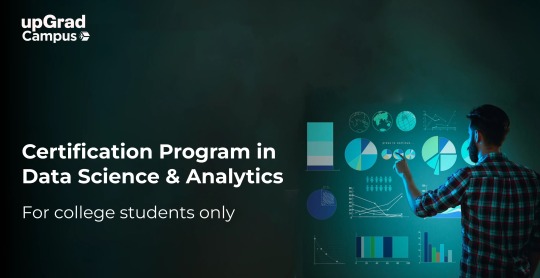#data analysis courses for beginners
Explore tagged Tumblr posts
Text
Why SAS Programming Remains Essential in the Era of Python and R
In the fast-changing world of data analytics, programming languages such as Python and R have gained considerable popularity. However, SAS programming continues to hold a pivotal role, especially in sectors where data integrity and regulatory compliance are paramount. Let's explore the reasons why SAS programming continues to be essential.
1. Proven Reliability in Regulated Industries
SAS programming has been a cornerstone in industries such as healthcare, finance, and pharmaceuticals for decades. Its robust framework ensures data accuracy and compliance with stringent regulatory standards. Organizations like the FDA and major financial institutions often mandate the use of SAS due to its validated processes and audit trails.
2. Comprehensive Data Management Capabilities
One of the strengths of sas programming lies in its ability to handle vast datasets efficiently. With built-in procedures for data cleaning, transformation, and analysis, SAS provides a one-stop solution for data professionals. Its ability to manage complex data workflows with ease makes it a preferred choice for large-scale data projects.
3. Seamless Integration with Modern Technologies
While SAS has its roots in traditional data analysis, it has evolved to integrate with modern technologies. The introduction of SAS Viya allows for cloud-based analytics, enabling users to leverage the power of sas programming in scalable and flexible environments. Additionally, SAS now offers interfaces with Python and R, allowing for a hybrid approach to data analysis.
4. Extensive Support and Documentation
SAS offers comprehensive documentation and a supportive community, making it accessible for both beginners and seasoned professionals. The wealth of resources available ensures that users can find solutions to challenges and continuously enhance their sas programming skills.
youtube
5. Career Opportunities and Industry Demand
Proficiency in sas programming opens doors to numerous career opportunities. Many organizations specifically seek professionals skilled in SAS due to its widespread use in critical business functions. Mastery of SAS can lead to roles in data analysis, statistical modeling, and business intelligence, among others.
Conclusion
While new programming languages continue to occur, sas programming maintains its relevance through its reliability, comprehensive capabilities, and adaptability. For professionals aiming to excel in data-centric roles, investing in SAS skills remains a strategic choice.
#sas programming tutorial#sas tutorial#sas programming#sas programming course#sas tutorial for beginners#data analyst#data analysis#Youtube
0 notes
Text
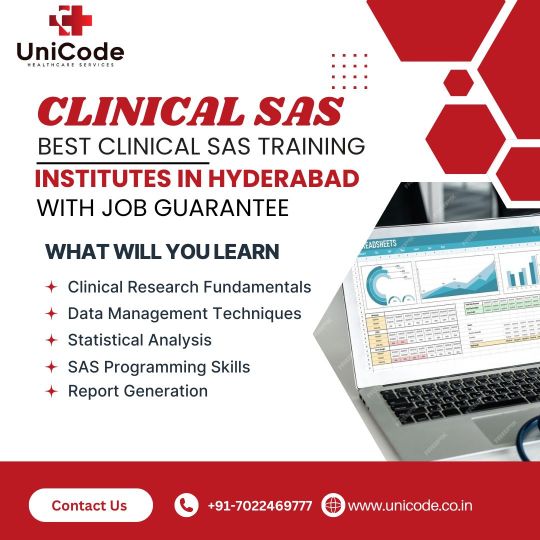
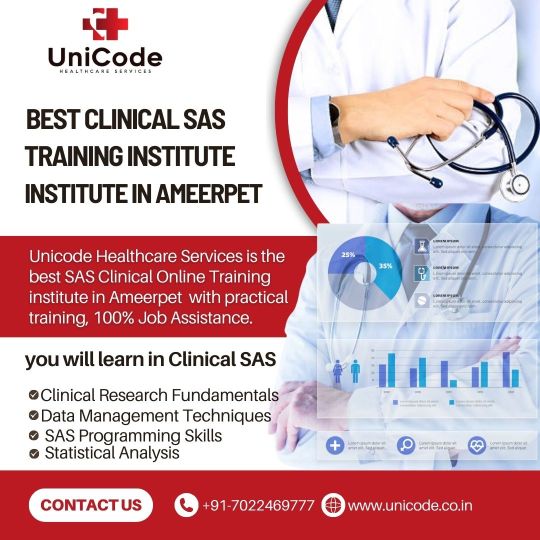
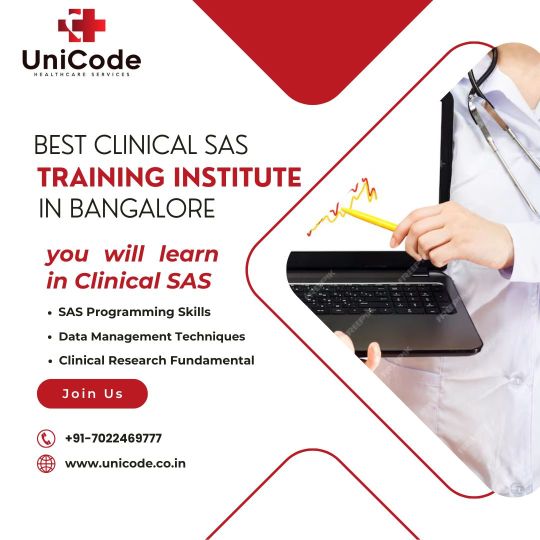
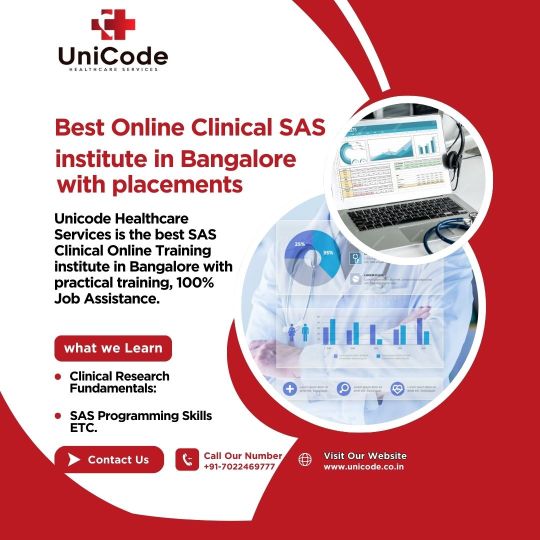
#Best Clinical SAS Training Institute in Hyderabad#Unicode Healthcare Services stands out as the top Clinical SAS training institute in Ameerpet#Hyderabad. Our comprehensive program is tailored to provide a deep understanding of Clinical SAS and its various features. The curriculum i#analytics#reporting#and graphical presentations#catering to both beginners and advanced learners.#Why Choose Unicode Healthcare Services for Clinical SAS Training?#Our team of expert instructors#with over 7 years of experience in the Pharmaceutical and Healthcare industries#ensures that students gain practical knowledge along with theoretical concepts. Using real-world examples and hands-on projects#we prepare our learners to effectively use Clinical SAS in various professional scenarios.#About Clinical SAS Training#Clinical SAS is a powerful statistical analysis system widely used in the Pharmaceutical and Healthcare industries to analyze and manage cl#and reporting.#The program includes both classroom lectures and live project work#ensuring students gain practical exposure. By completing the training#participants will be proficient in data handling#creating reports#and graphical presentations.#Course Curriculum Highlights#Our Clinical SAS course begins with the fundamentals of SAS programming#including:#Data types#variables#and expressions#Data manipulation using SAS procedures#Techniques for creating graphs and reports#Automation using SAS macros#The course also delves into advanced topics like CDISC standards
0 notes
Text
Your Career with a Google Data Studio Course in Vasai-Virar
Introduction: Mastering Data Visualization
In today's data-driven world, the ability to analyze and visualize data is crucial for making informed decisions. Google Data Studio is a powerful tool that allows users to create interactive and dynamic reports and dashboards. Whether you're a student, a marketing professional, or a data analyst, learning Google Data Studio can significantly enhance your data presentation skills. Enrolling in a Google Data Studio Course in Vasai-Virar will equip you with these essential skills. This article will explore the benefits of learning Google Data Studio, the demand for data visualization expertise, career opportunities, and why HrishiComputer is the best place to learn.
Why Learn Google Data Studio?
Learning Google Data Studio offers numerous benefits that can enhance various aspects of your professional life:
Enhanced Data Reporting: Google Data Studio enables you to turn raw data into insightful visualizations. By enrolling in a Google Data Studio Course in Vasai-Virar, you can learn how to create compelling reports that clearly communicate key metrics and trends.
Improved Decision-Making: Effective data visualization helps identify patterns and insights quickly, leading to better decision-making. Mastering Google Data Studio can help you provide valuable data-driven recommendations.
Career Advancement: Proficiency in Google Data Studio is a highly sought-after skill in many industries, including marketing, finance, and healthcare. Completing a Google Data Studio Course in Vasai-Virar can make you a more competitive candidate and open up new career opportunities.
Growing Demand for Data Visualization Skills
The ability to visualize data effectively is increasingly important as more businesses rely on data to drive their strategies. Companies need professionals who can transform complex data sets into clear, actionable insights. Enrolling in a Google Data Studio Course in Vasai-Virar will prepare you for roles such as data analyst, business intelligence specialist, and marketing analyst, where data visualization is a critical skill.
Career Opportunities and Earnings with Google Data Studio Skills
Career opportunities for those skilled in Google Data Studio are diverse and often come with attractive salary packages:
Data Analyst: Analyzing data sets and creating visual reports to support business decisions. Data analysts typically earn between INR 4,00,000 and INR 7,00,000 annually.
Business Intelligence Specialist: Developing and maintaining business intelligence tools and dashboards. Salaries for these roles range from INR 5,00,000 to INR 9,00,000 per year.
Marketing Analyst: Using data to analyze market trends and measure the effectiveness of marketing campaigns. Marketing analysts can earn between INR 3,50,000 and INR 6,00,000 annually.
Google Data Studio Course Syllabus at HrishiComputer
HrishiComputer in Vasai-Virar offers a comprehensive Google Data Studio Course designed to equip you with essential data visualization skills. The syllabus includes:
Introduction to Google Data Studio: Learn the basics of data visualization and navigate the Google Data Studio interface.
Connecting Data Sources: Understand how to connect various data sources, including Google Analytics, Google Sheets, and SQL databases, to Google Data Studio.
Building Reports and Dashboards: Gain hands-on experience in creating, customizing, and managing reports and dashboards.
Using Visualization Tools: Explore different types of charts and visualizations, such as bar charts, pie charts, and geo maps, to effectively represent your data.
Advanced Features: Learn advanced techniques such as creating calculated fields, blending data, and using filters to create dynamic reports.
Collaboration and Sharing: Discover how to share your reports and collaborate with team members in real-time.
Why Choose HrishiComputer for Google Data Studio Training?
HrishiComputer in Vasai-Virar is a top choice for learning Google Data Studio due to its comprehensive curriculum and expert instruction. Here’s why our Google Data Studio Course stands out:
Experienced Instructors: Our trainers are certified professionals with extensive experience in data visualization and Google Data Studio. They provide practical insights and hands-on guidance.
Interactive Learning: The course includes real-world projects and practical exercises, ensuring that you gain the skills needed to create impactful data visualizations.
Recognized Certification: Upon completing the course, you will receive a certification from HrishiComputer, which is highly valued by employers and enhances your resume.
Affordable Fees: We offer competitive pricing to make our courses accessible to everyone. Our goal is to provide quality education at an affordable cost.
How to Enroll
Ready to enhance your data visualization skills and boost your career prospects? Enroll in our Google Data Studio Course in Vasai-Virar at HrishiComputer. Our comprehensive training program is designed to equip you with the skills needed to excel in today’s data-driven world.
Sign Up for Google Data Studio Training at HrishiComputer and start transforming your data skills today!
Frequently Asked Questions (FAQ)
Q1: Do I need prior experience with data visualization to join the course?A: No prior experience is necessary. The course is suitable for both beginners and those looking to enhance their data visualization skills.
Q2: What type of certification will I receive upon completion?A: Upon successful completion of the course, you will receive a certification from HrishiComputer, recognized by many employers.
Q3: Are classes conducted online or offline?A: The primary mode of instruction is offline, providing a hands-on learning experience. However, we also offer supplementary online resources.
Q4: What is the duration of the course?A: The course typically spans 8 weeks, with flexible scheduling options to accommodate students and working professionals.
Q5: How can data visualization skills benefit my career?A: Data visualization skills are highly valuable across various job roles, enhancing your ability to interpret and communicate data effectively. These skills make you a more attractive candidate to employers and can lead to better job opportunities and higher earnings.
By completing this course, you will gain a comprehensive understanding of Google Data Studio, from basic functionalities to advanced features. This will empower you to create impactful data visualizations and make informed, data-driven decisions. Join HrishiComputer today and master the skills essential for success in the modern workplace.
#Google Data Studio Course in Vasai-Virar#Learn Google Data Studio in Vasai-Virar#Data Visualization Course Vasai-Virar#Google Data Studio Training Vasai-Virar#Google Data Studio Certification Vasai-Virar#Best Google Data Studio Course Vasai-Virar#Data Studio Classes in Vasai-Virar#Google Data Studio for Beginners Vasai-Virar#Advanced Google Data Studio Vasai-Virar#Google Data Studio Workshop Vasai-Virar#Professional Google Data Studio Course Vasai-Virar#Google Data Studio Skills Vasai-Virar#Data Analysis with Google Data Studio Vasai-Virar#Google Data Studio Training Institute Vasai-Virar#Interactive Data Reports Vasai-Virar#Long-Tail Keywords:#Google Data Studio Course with Certification in Vasai-Virar#How to use Google Data Studio for Data Visualization Vasai-Virar#Best Training for Google Data Studio in Vasai-Virar#Top Google Data Studio Classes in Vasai-Virar#Affordable Google Data Studio Course in Vasai-Virar#Google Data Studio Course for Professionals Vasai-Virar#Enhance Data Skills with Google Data Studio in Vasai-Virar
0 notes
Text
#datascience#Data Science and Machine Learning#Big Data Certification#Big Data Analytics Courses#Data Science Training#Data Science for Beginners#Data Science Online Training#Data Analysis Training#Data Science Course Near me#Data Science Classes
1 note
·
View note
Text
thinking about the two instruments I’ve seen people on the enterprise-d playing on my watch through so far and what they say about them, right, so.
first, riker’s infamous trombone. I think the thing about the trombone is that it is a nerd instrument. like yeah you can play jazz trombone and that’s very sexy, but also I know no one who still plays trombone as an adult and just plays trombone. every trombonist I know also can play trumpet, or tuba, or french horn, and also they probably can play sax too even though that one’s a woodwind. because they’re music nerds! and it makes sense! trombone is such a music nerds instrument! and I think it’s interesting because that fits him. he’s the kind of guy who cooks even though replicators exist. he’s the kind of guy who works hard at everything he does. and he’s the kind of guy who would be the trombonist in a band but could pick up any of the other instruments in a pinch, is what I’m saying.
but I also think it’s really interesting that the other musician I’ve seen so far is data learning the violin. notably, I don’t know if I’ve seen him trying to play it solo much—he seems to be a part of a string quartet, which is interesting given that a violin very much can be a soloist’s instrument! it’s also normally the melody of a string quartet. I think the most interesting detail here is that he seems to largely play classical pieces, and mentions that he feels he “lacks soul” and is merely combining other classical artists, because… classical music is ALL ABOUT building and iterating on the artists before you. it’s an interesting subtle way to say “hey data is more human than he thinks” that’s then made less subtle by picard just saying this that’s fun to think about. also interesting is… so violin is famously technically tricky for beginners, which fits data, but a violin is often a beginner’s instrument! this is because you can buy a beginner’s violin for like thirty dollars, and because learning violin teaches you the principles for a lot of other string instruments. it’s just being actually GOOD at it is very hard. which makes it as an instrument for data to try very interesting to me; why violin of the typical beginner instruments? why not, say, piano or guitar? and I think the answer to that is both “I think data likes classical music” and “violin is a very emotional instrument that can do a WIDE range of things, which is why data picked it over other options”.
this is of course complete over-analysis but I LOVE when characters play instruments and do music together. anyway the style of music that would incorporate both trombone and violin that I picture is in the corner of music that’s where jazz and bluegrass and blues sort of intersect, so that’d be fun. I think data should learn some fiddle playing,
#Star Trek#tng#star trek tng#data soong#william riker#this has been your instrument analysis for the day#tune in for more really in character posts from second later about poker strategies—
40 notes
·
View notes
Text
instagram
Learning to code and becoming a data scientist without a background in computer science or mathematics is absolutely possible, but it will require dedication, time, and a structured approach. ✨👌🏻 🖐🏻Here’s a step-by-step guide to help you get started:
1. Start with the Basics:
- Begin by learning the fundamentals of programming. Choose a beginner-friendly programming language like Python, which is widely used in data science.
- Online platforms like Codecademy, Coursera, and Khan Academy offer interactive courses for beginners.
2. Learn Mathematics and Statistics:
- While you don’t need to be a mathematician, a solid understanding of key concepts like algebra, calculus, and statistics is crucial for data science.
- Platforms like Khan Academy and MIT OpenCourseWare provide free resources for learning math.
3. Online Courses and Tutorials:
- Enroll in online data science courses on platforms like Coursera, edX, Udacity, and DataCamp. Look for beginner-level courses that cover data analysis, visualization, and machine learning.
4. Structured Learning Paths:
- Follow structured learning paths offered by online platforms. These paths guide you through various topics in a logical sequence.
5. Practice with Real Data:
- Work on hands-on projects using real-world data. Websites like Kaggle offer datasets and competitions for practicing data analysis and machine learning.
6. Coding Exercises:
- Practice coding regularly to build your skills. Sites like LeetCode and HackerRank offer coding challenges that can help improve your programming proficiency.
7. Learn Data Manipulation and Analysis Libraries:
- Familiarize yourself with Python libraries like NumPy, pandas, and Matplotlib for data manipulation, analysis, and visualization.
For more follow me on instagram.
#studyblr#100 days of productivity#stem academia#women in stem#study space#study motivation#dark academia#classic academia#academic validation#academia#academics#dark acadamia aesthetic#grey academia#light academia#romantic academia#chaotic academia#post grad life#grad student#graduate school#grad school#gradblr#stemblog#stem#stemblr#stem student#engineering college#engineering student#engineering#student life#study
7 notes
·
View notes
Text
Free online courses for bioinformatics beginners
🔬 Free Online Courses for Bioinformatics Beginners 🚀
Are you interested in bioinformatics but don’t know where to start? Whether you're from a biotechnology, biology, or computer science background, learning bioinformatics can open doors to exciting opportunities in genomics, drug discovery, and data science. And the best part? You can start for free!
Here’s a list of the best free online bioinformatics courses to kickstart your journey.
📌 1. Introduction to Bioinformatics – Coursera (University of Toronto)
📍 Platform: Coursera 🖥️ What You’ll Learn:
Basic biological data analysis
Algorithms used in genomics
Hands-on exercises with biological datasets
🎓 Why Take It? Ideal for beginners with a biology background looking to explore computational approaches.
📌 2. Bioinformatics for Beginners – Udemy (Free Course)
📍 Platform: Udemy 🖥️ What You’ll Learn:
Introduction to sequence analysis
Using BLAST for genomic comparisons
Basics of Python for bioinformatics
🎓 Why Take It? Short, beginner-friendly course with practical applications.
📌 3. EMBL-EBI Bioinformatics Training
📍 Platform: EMBL-EBI 🖥️ What You’ll Learn:
Genomic data handling
Transcriptomics and proteomics
Data visualization tools
🎓 Why Take It? High-quality training from one of the most reputable bioinformatics institutes in Europe.
📌 4. Introduction to Computational Biology – MIT OpenCourseWare
📍 Platform: MIT OCW 🖥️ What You’ll Learn:
Algorithms for DNA sequencing
Structural bioinformatics
Systems biology
🎓 Why Take It? A solid foundation for students interested in research-level computational biology.
📌 5. Bioinformatics Specialization – Coursera (UC San Diego)
📍 Platform: Coursera 🖥️ What You’ll Learn:
How bioinformatics algorithms work
Hands-on exercises in Python and Biopython
Real-world applications in genomics
🎓 Why Take It? A deep dive into computational tools, ideal for those wanting an in-depth understanding.
📌 6. Genomic Data Science – Harvard Online (edX) 🖥️ What You’ll Learn:
RNA sequencing and genome assembly
Data handling using R
Machine learning applications in genomics
🎓 Why Take It? Best for those interested in AI & big data applications in genomics.
📌 7. Bioinformatics Courses on BioPractify (100% Free)
📍 Platform: BioPractify 🖥️ What You’ll Learn:
Hands-on experience with real datasets
Python & R for bioinformatics
Molecular docking and drug discovery techniques
🎓 Why Take It? Learn from domain experts with real-world projects to enhance your skills.
🚀 Final Thoughts: Start Learning Today!
Bioinformatics is a game-changer in modern research and healthcare. Whether you're a biology student looking to upskill or a tech enthusiast diving into genomics, these free courses will give you a strong start.
📢 Which course are you excited to take? Let me know in the comments! 👇💬
#Bioinformatics#FreeCourses#Genomics#BiotechCareers#DataScience#ComputationalBiology#BioinformaticsTraining#MachineLearning#GenomeSequencing#BioinformaticsForBeginners#STEMEducation#OpenScience#LearningResources#PythonForBiologists#MolecularBiology
7 notes
·
View notes
Text
Why Learning Python is the Perfect First Step in Coding
Learning Python is an ideal way to dive into programming. Its simplicity and versatility make it the perfect language for beginners, whether you're looking to develop basic skills or eventually dive into fields like data analysis, web development, or machine learning.
Start by focusing on the fundamentals: learn about variables, data types, conditionals, and loops. These core concepts are the building blocks of programming, and Python’s clear syntax makes them easier to grasp. Interactive platforms like Codecademy, Khan Academy, and freeCodeCamp offer structured, step-by-step lessons that are perfect for beginners, so start there.
Once you’ve got a handle on the basics, apply what you’ve learned by building small projects. For example, try coding a simple calculator, a basic guessing game, or even a text-based story generator. These small projects will help you understand how programming concepts work together, giving you confidence and helping you identify areas where you might need a bit more practice.
When you're ready to move beyond the basics, Python offers many powerful libraries that open up new possibilities. Dive into pandas for data analysis, matplotlib for data visualization, or even Django if you want to explore web development. Each library offers a set of tools that helps you do more complex tasks, and learning them will expand your coding skillset significantly.
Keep practicing, and don't hesitate to look at code written by others to see how they approach problems. Coding is a journey, and with every line you write, you’re gaining valuable skills that will pay off in future projects.
FREE Python and R Programming Course on Data Science, Machine Learning, Data Analysis, and Data Visualization
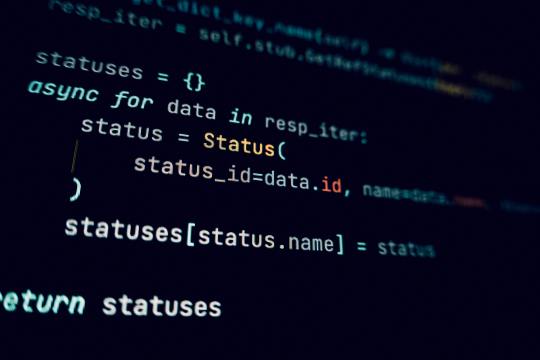
#learntocode#python for beginners#codingjourney#programmingbasics#web development#datascience#machinelearning#pythonprojects#codingcommunity#python#free course
10 notes
·
View notes
Note
Hey Meg! I was just catching up on your posts and wow, congrats on publishing the paper! I'm so excited for you and how far you'll go (it's so cool that you're working with alpha fold!!)! 🥳 How did you learn bioinformatics? Are there any resources you'd recommend for a complete beginner? (I'm trying to learn how to do proteomics analyses rn, but I can't seem to find many resources I can easily understand 🙈)
hii!! thank you so much for the wishes! the paper was a part of my final project with my team + guide so it was really a group effort <3 my teammates and I are all first authors, they were just kind enough to put my name first xD and yes! my current alphafold work is a lot of fun ^=^ I'm really enjoying my internship hehe
okay so I learnt bioinformatics as a part of my uni curriculum, and we mainly relied on these two textbooks
Essential Bioinformatics by Jin Xiong
Bioinformatics: Sequence and Genome Analysis
In addition to this, I also recently found this textbook titled Bioinformatics: An Introductory Textbook by Thomas Dandekar, Meik Kunz which focuses both on basic bioinformatics concepts and how to use the available tools. I especially like this book because I found it super easy to understand
EMBL also offers courses! even for synchronous online/in person courses that have ended, they tend to upload course materials. There's one for proteomics analyses as well- I've checked out the mass spectrometry videos under this course and they start with the very basics
In addition to these, here are some playlists on youtube that've helped:
Foundations of Systems and Computational Biology, MIT OpenCourseWare // classroom videos, I'd suggest to check specific videos for a topic of your choice rather than actually going through all of them
Computational Systems Biology, IITM // videos on the basics of systems biology, networks and modelling
Bioinformatics 101 // videos on how to use a lot of tools, however this primarily focuses on gene expression and RNA seq data
lastly, I don't know if this would be particularly helpful given what you're looking for, but this textbook on Computational Genomics with R is a blessing for Omics related Data Analysis. So if you ever need to use R in a biological context, this would be a great place to start
yeah! so these are the majority of the resources that I've used, I hope they help! Just a heads up that the links to the textbooks I mentioned in the beginning are direct download links and won't take you to any website.
If there's anything else I can help with, feel free to reach out ^=^ best of luck!
#if anyone has come across any helpful resources for bioinformatics feel free to add to this post...#so much of academia is hidden behind a paywall it's really a shame#I hope these will be of some help!#i don't use coursera/edx/etc so I didn't add any of those links on here#studyblr#resources#answered#bioinformatics#bio student#biology#regarding cpb
30 notes
·
View notes
Text
Python for Beginners: Launch Your Tech Career with Coding Skills
Are you ready to launch your tech career but don’t know where to start? Learning Python is one of the best ways to break into the world of technology—even if you have zero coding experience.
In this guide, we’ll explore how Python for beginners can be your gateway to a rewarding career in software development, data science, automation, and more.
Why Python Is the Perfect Language for Beginners
Python has become the go-to programming language for beginners and professionals alike—and for good reason:
Simple syntax: Python reads like plain English, making it easy to learn.
High demand: Industries spanning the spectrum are actively seeking Python developers to fuel their technological advancements.
Versatile applications: Python's versatility shines as it powers everything from crafting websites to driving artificial intelligence and dissecting data.
Whether you want to become a software developer, data analyst, or AI engineer, Python lays the foundation.
What Can You Do With Python?
Python is not just a beginner language—it’s a career-building tool. Here are just a few career paths where Python is essential:
Web Development: Frameworks like Django and Flask make it easy to build powerful web applications. You can even enroll in a Python Course in Kochi to gain hands-on experience with real-world web projects.
Data Science & Analytics: For professionals tackling data analysis and visualization, the Python ecosystem, featuring powerhouses like Pandas, NumPy, and Matplotlib, sets the benchmark.
Machine Learning & AI: Spearheading advancements in artificial intelligence development, Python boasts powerful tools such as TensorFlow and scikit-learn.
Automation & Scripting: Simple yet effective Python scripts offer a pathway to amplified efficiency by automating routine workflows.
Cybersecurity & Networking: The application of Python is expanding into crucial domains such as ethical hacking, penetration testing, and the automation of network processes.
How to Get Started with Python
Starting your Python journey doesn't require a computer science degree. Success hinges on a focused commitment combined with a thoughtfully structured educational approach.
Step 1: Install Python
Download and install Python from python.org. It's free and available for all platforms.
Step 2: Choose an IDE
Use beginner-friendly tools like Thonny, PyCharm, or VS Code to write your code.
Step 3: Learn the Basics
Focus on:
Variables and data types
Conditional statements
Loops
Functions
Lists and dictionaries
If you prefer guided learning, a reputable Python Institute in Kochi can offer structured programs and mentorship to help you grasp core concepts efficiently.
Step 4: Build Projects
Learning by doing is key. Start small:
Build a calculator
Automate file organization
Create a to-do list app
As your skills grow, you can tackle more complex projects like data dashboards or web apps.
How Python Skills Can Boost Your Career
Adding Python to your resume instantly opens up new opportunities. Here's how it helps:
Higher employability: Python is one of the top 3 most in-demand programming languages.
Better salaries: Python developers earn competitive salaries across the globe.
Remote job opportunities: Many Python-related jobs are available remotely, offering flexibility.
Even if you're not aiming to be a full-time developer, Python skills can enhance careers in marketing, finance, research, and product management.
If you're serious about starting a career in tech, learning Python is the smartest first step you can take. It’s beginner-friendly, powerful, and widely used across industries.
Whether you're a student, job switcher, or just curious about programming, Python for beginners can unlock countless career opportunities. Invest time in learning today—and start building the future you want in tech.
Globally recognized as a premier educational hub, DataMites Institute delivers in-depth training programs across the pivotal fields of data science, artificial intelligence, and machine learning. They provide expert-led courses designed for both beginners and professionals aiming to boost their careers.
Python Modules Explained - Different Types and Functions - Python Tutorial
youtube
#python course#python training#python#learnpython#pythoncourseinindia#pythoncourseinkochi#pythoninstitute#python for data science#Youtube
3 notes
·
View notes
Text
The Essential SAS Tutorial: Techniques and Tips for Data Analysis
SAS programming is an industry-standard tool for statistical analysis and data management. Widely used by professionals in fields such as healthcare, finance, marketing, and government, SAS programming provides a comprehensive suite of tools to handle, analyze, and derive insights from data. Whether you're new to SAS or looking to sharpen your skills, this tutorial will guide you through key techniques and tips for data analysis using SAS.
Getting Started with SAS Programming
To get started with SAS programming, it's important to understand its basic structure. SAS programming is made up of two main components: the DATA step and the PROC step.
The DATA step is where you manipulate, transform, and clean your data. It is used to read in raw data, create new variables, and apply conditions to filter or modify the data.
The PROC step is used for performing statistical analysis and generating reports. This is where you’ll apply procedures such as PROC MEANS, PROC FREQ, and PROC REG to perform analysis and generate output.
Understanding the basic syntax and flow of SAS programming is essential to successfully using the tool for data analysis.
youtube
Data Cleaning and Preparation
Data cleaning is one of the most important steps in the data analysis process. Raw data often contains missing values, errors, or inconsistencies that need to be addressed before any meaningful analysis can be conducted.
In SAS programming, the DATA step is commonly used to clean and prepare data. This includes tasks such as:
Handling Missing Data: You can use statements like IF and WHERE to filter out missing or invalid values.
Variable Transformation: Sometimes, you’ll need to create new variables based on existing data. SAS makes this easy with functions like SUM, MEAN, and LAG.
Merging Datasets: SAS allows you to merge datasets using the MERGE statement, which is essential for combining different sources of data into one unified dataset.
Effective data cleaning ensures that the analysis conducted is both accurate and reliable.
Exploratory Data Analysis (EDA)
Once the data is cleaned, the next step is Exploratory Data Analysis (EDA). This step involves summarizing the data, exploring relationships between variables, and identifying patterns or outliers. SAS programming offers several procedures to assist with EDA.
PROC MEANS: This procedure calculates descriptive statistics such as mean, standard deviation, and range.
PROC FREQ: SAS uses this procedure to generate frequency tables for categorical variables.
PROC UNIVARIATE: This procedure provides detailed statistical summaries and identifies potential outliers in the dataset.
EDA is crucial for understanding the data's structure and ensuring that any subsequent analysis is appropriate for the data at hand.
Statistical Modeling with SAS
After completing EDA, the next step is applying statistical models to the data. SAS programming offers a variety of procedures to fit models to data and make predictions.
Linear Regression: PROC REG is used for fitting linear regression models to examine relationships between continuous variables.
Logistic Regression: PROC LOGISTIC is used for fitting logistic regression models to predict binary outcomes (e.g., success/failure).
Time Series Analysis: PROC ARIMA is a specialized procedure for analyzing and forecasting time series data.
By applying statistical models, you can gain deeper insights into the data and make predictions about future trends or behaviors.
Data Visualization in SAS
Finally, once your analysis is complete, it’s important to communicate the results effectively. SAS programming provides powerful tools for data visualization. The PROC SGPLOT procedure allows you to create a wide range of plots, such as histograms, box plots, and scatter plots, to visually represent your data. Additionally, SAS Visual Analytics provides interactive dashboards that make it easy to share findings with stakeholders.
Conclusion This SAS tutorial has outlined the essential techniques and tips for using SAS programming for data analysis. From cleaning and preparing data to applying statistical models and generating reports, SAS programming is an invaluable tool for transforming raw data into actionable insights. Whether you’re a beginner or an experienced analyst, mastering these techniques will enhance your ability to analyze data effectively and help organizations make data-driven decisions.
#sas tutorial#sas tutorial for beginners#sas programming#sas programming course#Data Analysis#Youtube
0 notes
Text
Scope Computers
🚀 Become a Data Science Expert – From Basics to Breakthroughs! Step into one of the most in-demand careers of the 21st century with our cutting-edge Data Science Course. Whether you're starting fresh or upskilling, this course is your gateway to mastering data analysis, machine learning, and AI-powered insights.
🔍 What You’ll Learn:
Programming with Python – from zero to hero
Data wrangling & visualization with Pandas, Matplotlib, and Seaborn
Machine Learning algorithms with Scikit-learn
Deep Learning with TensorFlow & Keras
Real-world projects & case studies from finance, healthcare, and e-commerce
Tools like Power BI, SQL, and more
🎯 Why This Course Stands Out: ✔ Beginner-friendly with step-by-step guidance ✔ Taught by experienced data scientists ✔ Project-based learning to build your portfolio ✔ Interview prep, resume building, and placement assistance ✔ Recognized certification upon completion
💼 Whether you aim to become a Data Analyst, Data Scientist, or AI Developer, this course equips you with the practical skills and confidence to succeed in today’s data-driven world.
✨ Start your journey today—no prior coding experience needed!

#scopecomputers#training#science#datasciencetraining#sciencebasedtraining#DataScience#OfflineTraining#CareerBoost#JodhpurCourse#DataScienceTraining#pythoncode#pythonlearning#machinelearningalgorithms#machinelearningengineering#artificial_intelligence#datascientist#dataanalyst#javaprogrammer#sqldeveloper
2 notes
·
View notes
Text
How to Become a Data Scientist in 2025 (Roadmap for Absolute Beginners)

Want to become a data scientist in 2025 but don’t know where to start? You’re not alone. With job roles, tech stacks, and buzzwords changing rapidly, it’s easy to feel lost.
But here’s the good news: you don’t need a PhD or years of coding experience to get started. You just need the right roadmap.
Let’s break down the beginner-friendly path to becoming a data scientist in 2025.
✈️ Step 1: Get Comfortable with Python
Python is the most beginner-friendly programming language in data science.
What to learn:
Variables, loops, functions
Libraries like NumPy, Pandas, and Matplotlib
Why: It’s the backbone of everything you’ll do in data analysis and machine learning.
🔢 Step 2: Learn Basic Math & Stats
You don’t need to be a math genius. But you do need to understand:
Descriptive statistics
Probability
Linear algebra basics
Hypothesis testing
These concepts help you interpret data and build reliable models.
📊 Step 3: Master Data Handling
You’ll spend 70% of your time cleaning and preparing data.
Skills to focus on:
Working with CSV/Excel files
Cleaning missing data
Data transformation with Pandas
Visualizing data with Seaborn/Matplotlib
This is the “real work” most data scientists do daily.
🧬 Step 4: Learn Machine Learning (ML)
Once you’re solid with data handling, dive into ML.
Start with:
Supervised learning (Linear Regression, Decision Trees, KNN)
Unsupervised learning (Clustering)
Model evaluation metrics (accuracy, recall, precision)
Toolkits: Scikit-learn, XGBoost
🚀 Step 5: Work on Real Projects
Projects are what make your resume pop.
Try solving:
Customer churn
Sales forecasting
Sentiment analysis
Fraud detection
Pro tip: Document everything on GitHub and write blogs about your process.
✏️ Step 6: Learn SQL and Databases
Data lives in databases. Knowing how to query it with SQL is a must-have skill.
Focus on:
SELECT, JOIN, GROUP BY
Creating and updating tables
Writing nested queries
🌍 Step 7: Understand the Business Side
Data science isn’t just tech. You need to translate insights into decisions.
Learn to:
Tell stories with data (data storytelling)
Build dashboards with tools like Power BI or Tableau
Align your analysis with business goals
🎥 Want a Structured Way to Learn All This?
Instead of guessing what to learn next, check out Intellipaat’s full Data Science course on YouTube. It covers Python, ML, real projects, and everything you need to build job-ready skills.
https://www.youtube.com/watch?v=rxNDw68XcE4
🔄 Final Thoughts
Becoming a data scientist in 2025 is 100% possible — even for beginners. All you need is consistency, a good learning path, and a little curiosity.
Start simple. Build as you go. And let your projects speak louder than your resume.
Drop a comment if you’re starting your journey. And don’t forget to check out the free Intellipaat course to speed up your progress!
2 notes
·
View notes
Text
When I was looking for a job my dad got me to take some online data analysis classes so I had something on the table, but my beginner course was five weeks long, and I only got a one week free trial, and I really did not feel like spending any money, so I just did five weeks of coursework in five-six days and got my certificate.
It's not very impressive but anyway, that's exactly what Raz was doing when he went to Whispering Rocks.
#someone else joked about raz speedrunning being a psychonaut at camp and compared it to being at band camp and becoming a professional-#in five days#and yeah. that's exactly what raz was doing and it's so funny it actually worked#thinking about it that's definitely a habit raz keeps up as he gets older. even if the deadline is weeks away he tries to get his work done-#as quick as he can with no exact reason for doing so.#poor baby has bags under his eyes and is always overestimated on a mix of caffeine and lack of sleep#babbling brooke#psychonauts#razputin aquato
15 notes
·
View notes
Text

Econometrics Demystified: The Ultimate Compilation of Top 10 Study Aids
Welcome to the world of econometrics, where economic theories meet statistical methods to analyze and interpret data. If you're a student navigating through the complexities of econometrics, you know how challenging it can be to grasp the intricacies of this field. Fear not! This blog is your ultimate guide to the top 10 study aids that will demystify econometrics and make your academic journey smoother.
Economicshomeworkhelper.com – Your Go-To Destination
Let's kick off our list with the go-to destination for all your econometrics homework and exam needs – https://www.economicshomeworkhelper.com/. With a team of experienced experts, this website is dedicated to providing high-quality assistance tailored to your specific requirements. Whether you're struggling with regression analysis or hypothesis testing, the experts at Economicshomeworkhelper.com have got you covered. When in doubt, remember to visit the website and say, "Write My Econometrics Homework."
Econometrics Homework Help: Unraveling the Basics
Before delving into the intricacies, it's crucial to build a strong foundation in the basics of econometrics. Websites offering econometrics homework help, such as Khan Academy and Coursera, provide comprehensive video tutorials and interactive lessons to help you grasp fundamental concepts like linear regression, correlation, and statistical inference.
The Econometrics Academy: Online Courses for In-Depth Learning
For those seeking a more immersive learning experience, The Econometrics Academy offers online courses that cover a wide range of econometrics topics. These courses, often led by seasoned professors, provide in-depth insights into advanced econometric methods, ensuring you gain a deeper understanding of the subject.
"Mastering Metrics" by Joshua D. Angrist and Jörn-Steffen Pischke
No compilation of study aids would be complete without mentioning authoritative books, and "Mastering Metrics" is a must-read for econometrics enthusiasts. Authored by two renowned economists, Joshua D. Angrist and Jörn-Steffen Pischke, this book breaks down complex concepts into digestible chapters, making it an invaluable resource for both beginners and advanced learners.
Econometrics Forums: Join the Conversation
Engaging in discussions with fellow econometrics students and professionals can enhance your understanding of the subject. Platforms like Econometrics Stack Exchange and Reddit's econometrics community provide a space for asking questions, sharing insights, and gaining valuable perspectives. Don't hesitate to join the conversation and expand your econometrics network.
Gretl: Your Free Econometrics Software
Practical application is key in econometrics, and Gretl is the perfect tool for hands-on learning. This free and open-source software allows you to perform a wide range of econometric analyses, from simple regressions to advanced time-series modeling. Download Gretl and take your econometrics skills to the next level.
Econometrics Journal Articles: Stay Updated
Staying abreast of the latest developments in econometrics is essential for academic success. Explore journals such as the "Journal of Econometrics" and "Econometrica" to access cutting-edge research and gain insights from scholars in the field. Reading journal articles not only enriches your knowledge but also equips you with the latest methodologies and approaches.
Econometrics Bloggers: Learn from the Pros
Numerous econometrics bloggers share their expertise and experiences online, offering valuable insights and practical tips. Follow blogs like "The Unassuming Economist" and "Econometrics by Simulation" to benefit from the expertise of professionals who simplify complex econometric concepts through real-world examples and applications.
Econometrics Software Manuals: Master the Tools
While software like STATA, R, and Python are indispensable for econometric analysis, navigating through them can be challenging. Refer to comprehensive manuals and documentation provided by these software platforms to master their functionalities. Understanding the tools at your disposal will empower you to apply econometric techniques with confidence.
Econometrics Webinars and Workshops: Continuous Learning
Finally, take advantage of webinars and workshops hosted by academic institutions and industry experts. These events provide opportunities to deepen your knowledge, ask questions, and engage with professionals in the field. Check out platforms like Econometric Society and DataCamp for upcoming events tailored to econometrics enthusiasts.
Conclusion
Embarking on your econometrics journey doesn't have to be daunting. With the right study aids, you can demystify the complexities of this field and excel in your academic pursuits. Remember to leverage online resources, engage with the econometrics community, and seek assistance when needed. And when the workload becomes overwhelming, don't hesitate to visit Economicshomeworkhelper.com and say, "Write My Econometrics Homework" – your trusted partner in mastering econometrics. Happy studying!
13 notes
·
View notes
